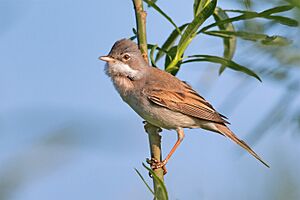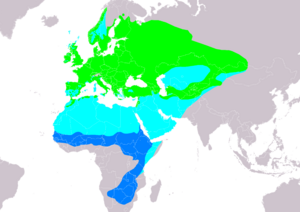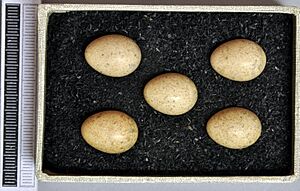Common whitethroat facts for kids
Quick facts for kids Common whitethroat |
|
|---|---|
 |
|
| Conservation status | |
| Scientific classification | |
 |
|
| Range of C. communis Breeding Passage Non-breeding | |
| Synonyms | |
|
Sylvia communis Latham, 1787 |
The common whitethroat (Curruca communis) is a small, common bird found across Europe and parts of Asia. It's a type of warbler, known for its sweet songs. This bird is a strong migrator, meaning it travels long distances. Every year, it flies from its breeding grounds in Europe and Asia to warmer places like tropical Africa, Arabia, and Pakistan for winter.
About the Common Whitethroat
The common whitethroat was first described by an English bird expert named John Latham in 1787. He gave it the scientific name Sylvia communis. The word communis is Latin for "common," which makes sense because it's a widespread bird. Today, scientists place this bird in a different group, or genus, called Curruca.
There are a few different types, or subspecies, of the common whitethroat. They are mostly found in different areas:
- C. c. communis: This type lives and breeds in Europe, reaching as far as northern Turkey and North Africa. It spends its winters in western and central Africa.
- C. c. volgensis: You can find this subspecies breeding in southeastern European Russia, western Siberia, and northern Kazakhstan. It flies to eastern and southern Africa for the winter.
- C. c. icterops: This type breeds from central Turkey all the way to Turkmenistan and Iran. Like the others, it winters in eastern and southern Africa.
- C. c. rubicola: This subspecies breeds in the mountains of Central Asia. It also travels to eastern and southern Africa for the colder months.
What Does It Look Like?
Common whitethroats are mostly brown on top and a lighter, buff color underneath. Their wings have pretty chestnut-colored edges. Male and female whitethroats look a bit different.
The adult male has a grey head and a bright white throat. The female, however, does not have the grey head, and her throat is a duller white.
Their song is very quick and sounds a bit scratchy. It can sometimes sound like they are scolding! Their usual call sounds like wed-wed or woid-woid. If they sense danger, they make a long, rough sound like tschehr.
Where Do They Live and What Do They Eat?
Common whitethroats like open areas and farmlands. They especially enjoy places with bushes, as these are perfect for building their nests. They usually build their nests in low shrubs or brambles. A female whitethroat will lay about 3 to 7 eggs.
Like most warblers, these birds mainly eat insects. However, they also enjoy eating berries and other soft fruit, especially when getting ready for their long migration journeys.





